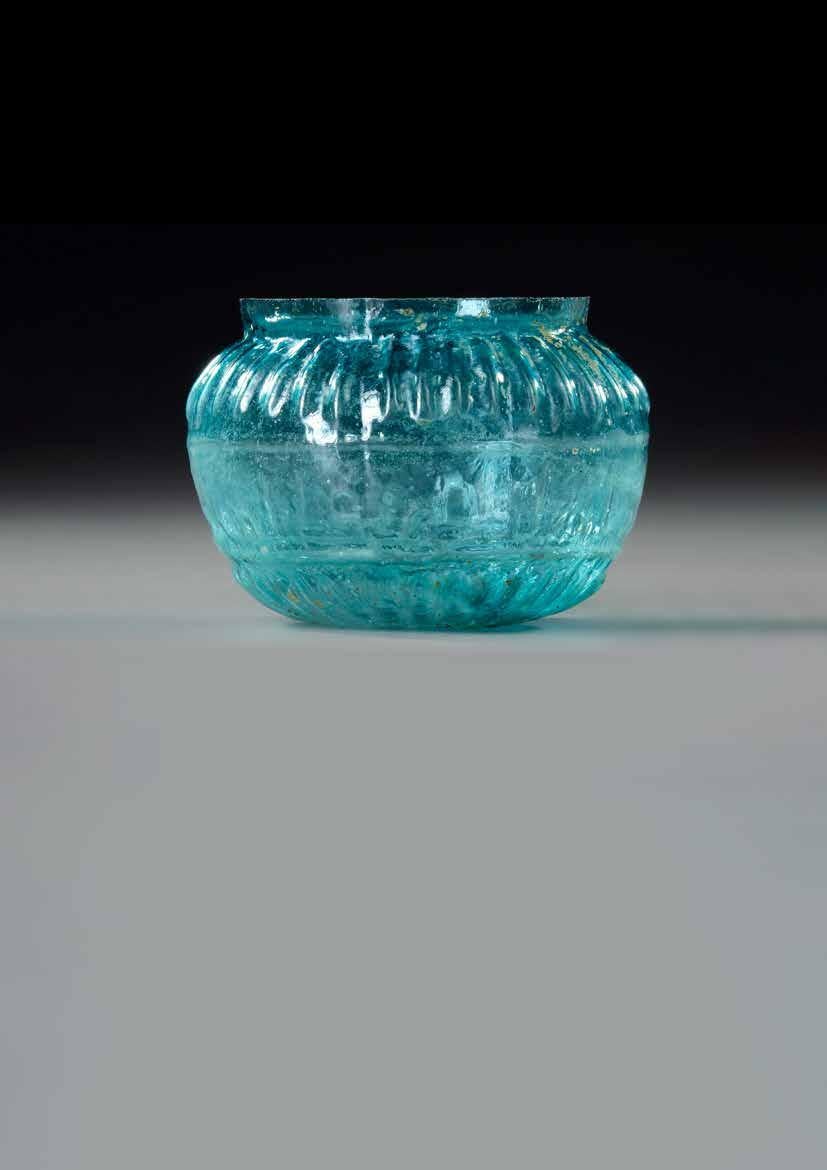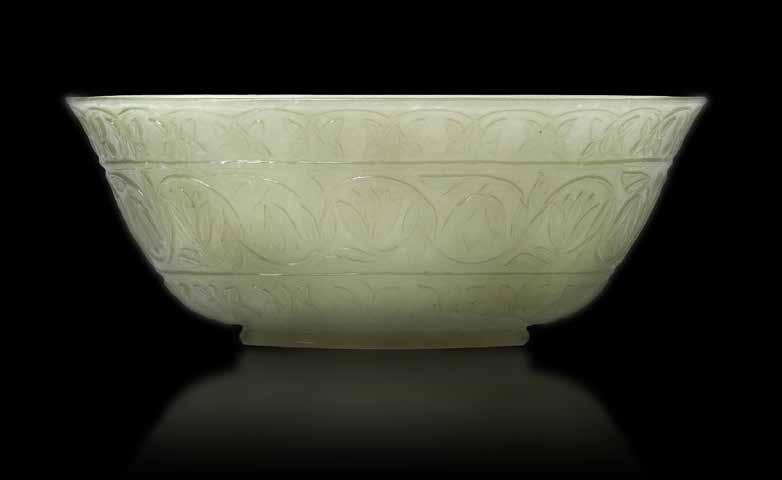
7 minute read
A CELADON JADE MUGHAL-STYLE BOWL, 17TH CENTURY
The steep sides rising from a short spreading chrysanthemum-shaped foot to a slightly flared rim, carved in low relief to the exterior with three rows of stylised floral foliates, the stone of a pale celadon tone.
Diameter: 13.6 cm.
Advertisement
PROVENANCE
Collection of Edward George Robey (1869-1954).
Estimate € 30.000 - € 40.000
AN OTTOMAN JADE AND JEWEL-SET GILT SILVER BELT BUCKLE TURKEY, 17TH CENTURY
A slightly curved gilt silver belt, with a central aperture and hidden sliding hinge, four thin stays on underside to fasten belt, the front worked in repoussé with foliate scrolls, set with encrusted jade plaques inlaid with gold and colorful stones, bordered by further stones set into shallow bud-shaped settings. 25 by 11 cm.
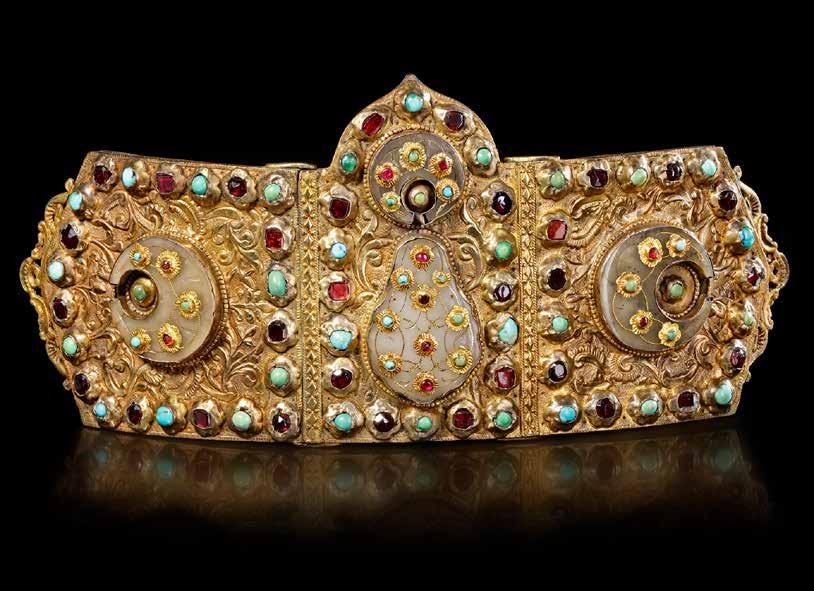
Catalogue Note
This magnificent belt buckle belongs to a very small group of Ottoman buckles decorated in such an extravagant manner which are known to exist. One is in the Topkapi Saray Collection and another in the Benaki Museum (Ballian 1992, p.96-97, no.53). Another similar example, dated to the sixteenth century, now in the Museum für Kunsthandwerk, Frankfurt, inv. no. 14320, displays a similar pattern of arrangement, with inset jade plaques and colourful gemstones on a repoussé ground. The colorful stones bordering each plaque of the buckle were each set into bud-shaped clasps using a technique known as mihlama (R. Hasson, Later Islamic Jewellery, L.A. Mayer Memorial Institute for Islamic Art, Jerusalem 1987, p.11, no. 3). The Ottoman tradition of setting jade and gemstones into metal objects intended for everyday use to embellish them can be seen on a number of different objects including small boxes, book covers, weapons (see following lot).
Estimate € 30.000 - € 50.000
A MUGHAL JADE PENDANT (HALDILI) MUGHAL INDIA, DATED 1013 AH/1607 AD
Of drop shape, the jade surface carved with 7 lines of extremely elegant nastaliq script with occasional floral flourishes, the final line dated, pinned through the centre to a 19th century gold mount decorated in repoussé with a floral spray issuing flower heads and fleshy leaves. 10 by 7.5 cm.
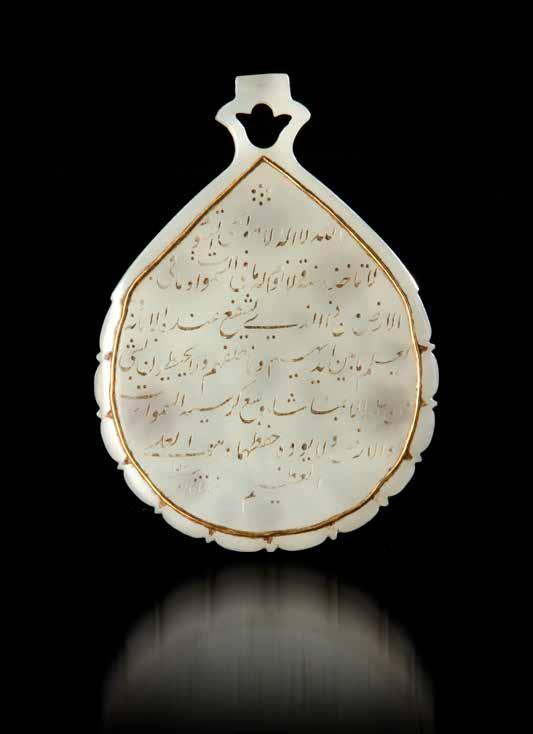
CATALOGUE NOTE
Dated 1013 AD and insipid with its owner Khan-i-Khanan. Abdul Rahim Khan-i-Khanan: Khanzada Mirza Khan Abdul Rahim (17 December 1556 – 1 October 1627), popularly known as simply Rahim and titled Khan-i-Khanan, was a poet who lived in India during the rule of Mughal emperor Akbar, who was his mentor. He was one of the nine important ministers (dewan) in his court, known as the Navaratnas. Rahim was known for his Hindi dohe (couplets) and his books on astrology. Apart from writing various dohas, Rahim translated Babar’s memoirs, Baburnama, from the Chagatai language to the Persian language, which was completed in 1589–90 AD. He had an excellent command over the Sanskrit language.
Estimate € 30.000 - € 50.000


FATIMID GOLD ROUNDEL WITH PEARL SURROUND, 10TH-11TH CENTURY

A very elaborate gold roundel with river pearls and stone and glass inlays. The roundel is an exceptional product of a master jeweler from the period of the hight of Fatimid craftsmanship during the hight of their empire. The disc shows the virtuoso technique of the Fatimid jewelers in creating elaborate surfaces by using filigreed wires and globules alone without the need for a foil base to work on. The surface is then applied with six hemispherical appliqués and the central decorative motif of a raised Star of David, decorated with granulation, with garnet and glass inlays. Around the edge six tubular hoops guide a wire with river pearls threaded onto it. On the back we see the star off David design repeated, this time covered in granulation and a fleur-du-lys motif spaced within the recesses.
Diameter: 5.7 cm.
Weight: 55.6 gr.
Catalogue Note
A similar roundel in the Metropolitan Museum is reckoned to have been an adornment for a headdress as seen on contemporary illustrations. The present piece has many motifs which point to it being Fatimid, notably the use of lines of filigreed globules used to frame the twisted wire spiraled elements at the front. The fact that this roundel is decorated at the back would not change the likely purpose of this specimen.
PROVENANCE
Private collection, Belgium
Estimate € 20.000 - € 30.000
A MAGNIFICENT FATIMID GOLD RING, 10TH-11TH CENTURY
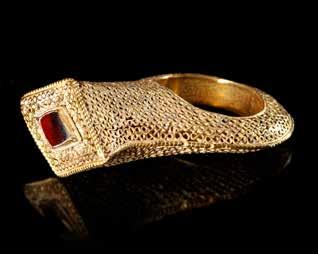

A very large and elaborate gold ring from the 10th-11th century. This exceptional ring shows off the extraordinary skill and virtuosity of the jewelers of the Fatimid period, something hardly seen before or since the period of the Fatimid Empire. The ring is built up of ‘8’ shaped elements made of flattened wire which are then filigreed to each other to form a sheet which is then fashioned into the required shape. The shank is lined from the inside by a plain gold sheet while all the other edges are formed by a beaded wire running along the joins.The bezel is in the form of a lozenge, and a cabochon garnet is set into the centre, held on a mount surrounded by a plain wire. The technique produced what in effect is a ‘cage’ of strength yet great lightness, a truly remarkable achievement. It is for this factor that the technique was never used again in later times. This ring stands as a testament to the opulence and level of craftsmanship reached during the Fatimid period in the urban centers of the manufacture of such items.
4.4 by 2.8 by 1.5 cm.
Weight: 12.6 gr
PROVENANCE
Private collection, Belgium
Estimate € 8000 - € 12.000
A PAIR OF LATE FATAMID GOLD EARRINGS, 12TH CENTURY

A pair of later Fatimid earrings from the end of the 12th century. The earrings are formed of a thick, circular wire with a device for closing the loop and three large globular beads which are threaded onto the wire and fixed by attachment with beaded spaces which are in turn soldered to the wire. The beads are made from thin sheet moulded into hemispheres which are then soldered at the edges to for a sphere. These were then in turned embellished with twisted wires and beads. The type originally derives from Byzantine prototypes and the interaction between the two cultures is well known in terms of borrowing from each other in the field of jewelry. They are exceptionally well preserved . 4.4 by 4.2 by 1.7 cm.
Weight: 28.1 gr.
PROVENANCE
Private collection, Belgium
Estimate € 5000 - € 8000
Lot 93
A GOLD AND SILVER RING, AYYUBID DYNASTY, 12TH CENTURY

A gold dinar with a cursive inscription within a gold border with arabesque design and shank with applied palmettes.
The inscription Al’amam ‘Ahmad
Height: 2.1 cm.
Weight: 7 gr.
Estimate € 1500 - € 2000
Lot 92
A GOLD ISLAMIC BRACELET
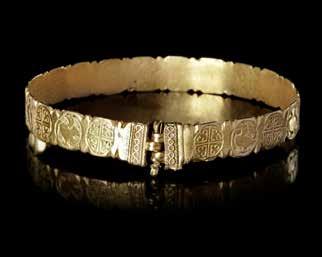
11TH-12TH CENTURY
A gold bracelet decorated with engraved birds (eagles?) alternating with stylized crosses with quartered with fleur de lys motifs. The motifs are engraved in roundels which alternate between the designs. There are traces of niello in the engraved recesses and this technique was widely used in the eastern Mediterranean at this time, the origins of which go back to the Romans. The clasp or closing mechanism is a commonly used triple lug mechanism which then closes with an inserted pin. The objects using this style are divided between Seljuks, Byzantines, Armenians within the area of Anatolia from where the most of these objects originate. Diameter: 6 cm 16 gr. weight.
PROVENANCE
Private collection, Belgium
Estimate € 1500 - € 2000
A MUGHAL GEM-SET ENAMELED GOLD NECKLACE
LATE 18TH CENTURY
Each square element set with nine ruby gem-stones with pendant pearls, the reverse decorated in red, green, white and turquoise enamels with floral motifs.
Width: 15 cm.
Weight: 69.07 gr.
Estimate € 3000 - € 5000
Lot 95
A MUGHAL GEM-SET ENAMELED GOLD NECKLACE
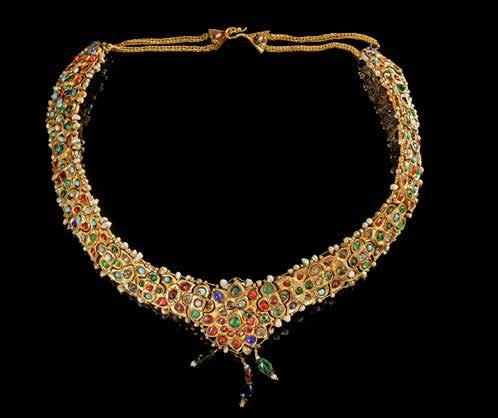

LATE 18TH CENTURY
Each floral shaped element set with ruby, emerald, turquoise and agate gem-stones.
Weight: 57.3 gr.
Length: 24 cm
Diameter: 10 cm.
PROVENANCE Private collection, France
Estimate € 2000 - € 3000
Lot 96
A SELJUK GOLD PENDANT PERSIA, 11TH-12TH CENTURY
Comprising a central inverted T-shape element of box construction, the face with figure-of-eight wire decoration, flanked on each side with confronted birds formed of scrolling wirework with applied similar wings and conical tails, one with a pronounced crest, three pendant beads of similar workmanship below with seed-pearls, a similar larger seed-pearl and suspension loop above. 6 by 4.5 cm.
Weight: 8 gr.
CATALOGUE NOTE
The motif of two confronted peacocks, found on Byzantine jewelry (Hasson, Rachel: Early Islamic Jewelry, Jerusalem, 1987, no.3, p. 13)
Estimate € 1000 - € 1200
Lot 97
AN EXCEPTIONALLY FINE AND RARE WHEEL-CUT AQUAMARINE PENDANT FATIMID, EGYPT, 10TH-11TH CENTURY
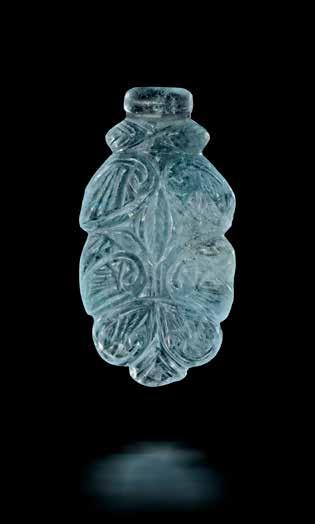
Of pear-shape, both sides wheel-cut with two bilaterally symmetrical palmettes and leaf scrolls, the top with drill hole for suspension 4.6 cm.
CATALOGUE NOTE
This pendant would have been worn as a talisman to protect the owner from harm. The aquamarine is traditionally believed to alleviate tension and reduce fear and anxiety, as well as mollifying aches and pains. In medieval times people widely believed in the physical as well as metaphysical properties of different minerals and scholars wrote extensively about them. One such was the Persian polymath, Abu al-Rayhan Muhammad ibn Ahmad al-Biruni (973-1048), whose list of notable publications includes a celebrated treatise on gemology, Kitab al-Jawahir, or “Book of Precious Stones”.
Estimate € 2000 - € 3000

Lot 98
A FATIMID ROCK CRYSTAL CHESS PIECE, EGYPT, 11TH CENTURY
The rock crystal of domed cylindrical form, carved with deep bevel-cut foliate designs and incised dash details.

7 by 5 cm.
PROVENANCE
Private collection, Belgium
CATALOGUE NOTE
The Fatimids mastered the carving of rock crystal in the tenth century, owing to their Caliphs’ abundant wealth which provided the means to commission such refined works. An impressive, although limited, corpus of remaining works which include ewers, flasks and chess pieces exhibits the exemplary skill of Fatimid craftsmen. This king or queen demonstrates both their affluence and the superior position they granted to the game of chess at this time.
The present lot is a rare example of Fatimid rock crystal carving and an interesting addition to the existing corpus of rock crystal gaming pieces of the period. The game of chess, which can be traced back through archaeological evidence to the second or third century, spread from the Indian subcontinent through Persia to centres such as Baghdad and Cairo, from where the present chess piece most probably originates. It can be attributed either to the Abbasid or Fatimid Caliphates as it shares a number of stylistic and technical features with examples of similar gaming pieces now in various museum collections.
Estimate € 8000 - € 12.000
Lot 99
A FATIMID IVORY CARVED BOX, EGYPT OR SYRIA 10TH-11TH CENTURY

Of rectangular form resting on three thicker carved bases, each side carved elegantly with two bands of angular Kufic inscription ( Fatimid Kufic script) above a band of rabbits.
8 by 16.5 cm
Estimate € 6000 - € 8000
Lot 100
TWELVE GLASS MOULDED FRAGMENTS, PERSIA OR CENTRAL ASIA
10TH-12TH CENTURY
Twelve rectangular shaped fragments, moulded each with the word “Allah”. Mounted and several sizes, approx. 1 by 1.2 cm / 0.8 by 1 cm.
Estimate € 1200 - € 1500
Lot 101




